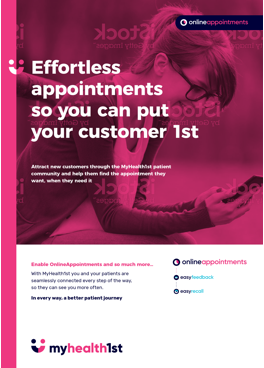
The coronavirus pandemic has had a drastic effect on employment in Australia. The official government numbers place the unemployment rate at 5.2%, but Goldman Sachs believes that the statistics may be misleading as they do not take into account the number of people not working but retained using the JobKeeper payments, older people not actively looking for work during the lockdown even if they would prefer to work, those furloughed at a reduced wage but still technically employed and people that have had their hours drastically cut.
Some medical professions were hit harder than others by the lockdown, such as optometrists and dentists who faced strict regulation on what kinds of services can be offered, but all medical professionals felt, and are still feeling the pinch.
As such, patients are booking fewer and fewer appointments. There are many reasons for this reticence to book a medical appointment, including fear of catching COVID-19, but one of the most pressing is financial uncertainty. Everybody is feeling the pinch in some way - even those currently working worry that their jobs may be in jeopardy.
Payment Plans
One of the surest ways to maintain a patient base when everyone is looking at the bottom line is to communicate a “care now, pay later” approach to your patients. Many people will put off a visit, test or treatment that may be needed due to the immediate financial strain, so giving them the option of having their needs taken care of and offering deferred payments or payments via installment gives them the confidence to get the help they need and reduce the chance of people defaulting on fees.
Australia has one of the best healthcare systems in the world both in terms of outcomes and insurance, both public and private, but even those with excellent private health insurance sometimes have large gap payments that can seem like an insurmountable hurdle. An emergency wisdom tooth removal might be covered by private health insurance, but might incur a gap payment for an anesthetist and other surgical needs. Similarly, something as simple as breaking a pair of glasses can make for a big bill at a moment’s notice.
While some people may have the money to pay a large bill upfront, research conducted by financial analysts in 2019 showed that almost half of Australians were living paycheque to paycheque , and could be financially undone by losing their job or a large, unexpected bill. There are no current research statistics on the number of people living in dire financial straits, but an increase in the number of people or households living from paycheque to paycheque or even day to day must have risen.
Payment plans allow patients to schedule payments over time, allowing them to integrate smaller payments into their budget rather than a single large payment.
Openpay is an Australian company that allows for easy, no interest payment plans. Once a payment is due and a plan has been agreed to, you will be paid the full fee (minus transaction and administration fees) and Openpay takes ownership of the repayments, performing any follow ups as may be needed without input from your business.
Offering similar financial and payment plan services, AfterPay has partnered with MyHealth1st to allow patients to search for and book dental appointments with practices that both offer AfterPay plans and are listed on the MyHealth1st Marketplace. Not only does this partnership offer an easy path to offering payment plans to patients, it also has the potential to drive new patients to your door.
Communication
Having clear lines of communication between your dental practice and patients, both existing and new, is vital. Being able to let the public know about any specials you may be offering, that you have payment plans available, or even spreading the message that you understand that things are tough right now in terms of both finances and confidence can help prompt otherwise reticent patients to book appointments.
- Social Media - Establishing and maintaining a social media presence, whether it’s on Twitter, Facebook or Instagram (or preferably all three) is an excellent way to cheaply disseminate information to your patients and create a rapport that can help to ease any fears of coming in for an appointment. As well as allaying fears of possibly contracting the coronavirus, social media posts are an excellent way to promote special offers or the availability of payment plans.
- Email Blasts - While not everyone who receives an email from their doctor is likely to open or read it, an email blast to all your patients on file is an extremely efficient way to let your patients know of any special offers, discounts or payment plans you may be offering.
- Reminders (email and SMS) - Reminders for booked appointments or recalls sent to patients for annual checkups can contain a brief message to reinforce the idea that your practice is safe to visit or that you understand that finances may be tight and you are willing to accept payment plans. SMS reminders and recalls are an effective way to ensure that your message is read, but brevity is key.
- Home Page Content - As many people will do some preliminary research online before committing to a new healthcare provider, keeping your homepage updated with relevant information is a great way to have returning or new patients learn about any steps you have made to reduce patient financial burden. Such information shown on your practice homepage can give you a leg up over other practices.
